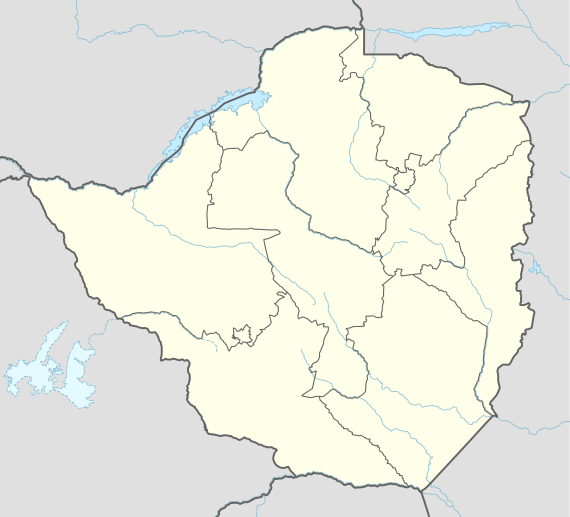Chimanimani
Chimanimani | |
|---|---|
Town | |
 Chimanimani Location of Chimanimani in Zimbabwe | |
| Coordinates: 19°48′00″S 32°51′36″E | |
| Country | Zimbabwe |
| Melsetter | 1892 |
| Chimanimani | 1982 |
| Elevation | 1,470 m (4,820 ft) |
| Population (2012 Census)[1] | |
| • Total | 6,815 |
| Time zone | UTC+2 (CAT) |
| Climate | Cwb |
| Website | Homepage |
| Dialling code: 26 (026 from within Zimbabwe) | |
Chimanimani is a town in Zimbabwe.
Location
Chimanimani is located in Chimanimani District, Manicaland Province, in south-eastern Zimbabwe, close to the border with Mozambique. The town lies about 120 kilometres (75 mi), by road, south of Mutare, the location of the provincial headquarters.[2] Its location lies approximately 365 kilometres (227 mi), by road, southeast of Harare, the capital of Zimbabwe and the largest city in that country.[3] The coordinates of the town of Chimanimani are:19° 48' 0.00"S, 32° 51' 36.00"E (Latitude:19.8000; Longitude:32.8600).
Despite a recent influx of Russian gem seekers, in late 2013 Chimanimani was said to have "virtually collapsed" and turned into a ghost town. Unemployment has recently peaked at unprecedented levels and tourism all but dissipated. So many shops have closed that residents are now commuting to Mutare for basic necessities.[4]
Main Sights:
Chimanimani has various nature-based attractions for visitors, most notably Bridal Veil Falls. The Bridal Veil picnic and camping site is located in a small national park about a 5 km walk, or a short drive, from the village. The falls itself plunges 50m down a sheer rock face into a crystal clear pool. Close to the town are the Arboretum, Green Mount, and Pork Pie sanctuary,- all offering attractive walks.
The Chimanimani Mountains are a short 18 km drive from the village. There are numerous hiking trails throughout the rugged Chimanimani range. Local guides are available. For adventure activities there is an Outward Bound centre nearby. It offers a range of activities and life-skill programs, accommodation and camping facilities, and access to the Paradise Pool. Other attractions in the Chimanimani Mountain range include the Nyakwaha and Haroni Botanical Reserves, as well as the Haroni and Mukurupiri waterfalls.
Climate
Chimanimani receives rainfall throughout the year. The average temperature is about 16 °C (61 °F).[5]
History
Chimanimani was founded by the brothers Thomas Moodie and Dunbar Moodie in 1892. In 1895 it was moved to its current site and was officially called Melsetter after Moodie's family home in Orkney in Scotland. Following Zimbabwe's independence in 1980, the name of the town was changed to Mandidzudzure, in 1982. However, after consultation with the population, the name was changed to Chimanimani.
Chimanimani is divided into 23 wards. Chimanimani West has 11 wards and its eastern counterpart has 12 wards. Major places in Chimanimani include Nyanyadzi, Gudyanga, Shinja, Mhakwe, Bechnough Bridge, Nhedziwa, Mutambara, Chikukwa, Chikwakwa, Sky Line, Outward bound, Copper, Ndima, Mutswangwa, Vhimba Wilderness and Hode.
The city was badly hit by Cyclone Idai in 2019, and was cut off due to damage to roads.[6]
Notable people from Chimanimani
Prominent people from Chimanimani include Samuel Undenge, Munacho Mutezo, Arthur Mutambara, Dr. Tafataona Mahoso , Hector Mugani, Michael Mugani, and Tendai Chatara. [Dr J. Mangudya]. Leon Sithole
Population
The 1982 national census estimated the population of the town at 1,370. In 2004, the population of Chimanimani was estimated at 2,752.[7] The next national population census in Zimbabwe is scheduled from 18 August 2012 through 28 August 2012.[8] Most of the inhabitants of Chimanimani are of Ndau origin.
See also
- Chimanimani District
- Manicaland Province
- Chimanimani National Park
References
- Zimbabwe National Statistics Agency. "2012 Census Provincial Report: Manicaland". Archived from the original on 19 May 2018. Retrieved 25 May 2018.
- Road Distance Between Mutare And Chimanimani With Map
- Map Showing Harare And Chimanimani With Distance Marker
- Chimanimani now a ghost town Archived 2 July 2014 at Archive.today
- "Climate: Chimanimani - Climate graph, Temperature graph, Climate table - Climate-Data.org". en.climate-data.org. Retrieved 16 January 2016.
- "Tropical Cyclone Idai may have killed more than 1,000 in Mozambique". The Economist. 19 March 2019. ISSN 0013-0613. Retrieved 19 March 2019.
- Estimated Population In 2004
- Next Population Census In Zimbabwe Scheduled For August 2012
External links
| Wikivoyage has a travel guide for Chimanimani. |